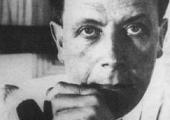|
Artist > Delaunay Robert (6 paintings.) |

Robert Delaunay (1885-1941) was a French painter often credited with painting the first abstract canvases based on theories of pure color around the year 1913.
Robert Delaunay was born in Paris on April 12, 1885, into a prominent family descended from French aristocracy; his mother used the title "Countess." His parents divorced when he was four years old, and he was subsequently raised by an aunt and uncle. An uninspired student, Delaunay did not pursue an education and instead apprenticed himself to a theater designer. Unlike most of the young painters of his generation, he had no formal art training. In 1910 he married Sonia Terk, a Russian painter who became a life-long collaborator and continued to work on shared ideas long after his death from cancer in 1941.
A prolific painter at an early age, Delaunay showed in the Salon exhibitions, the most important official shows in France, in his early 20s. He incorporated much of the restlessness of art during the first decade of the 20th century in his early work, passing through a Pointillist, a Nabi, then a Fauve phase. It was around 1912 that Delaunay came to believe that light could be expressed as pure color independent of any objective content. He declared that "color alone is form and content."
This idea ran counter to the Cubist ideas of Picasso and Braque, who were more interested in the analysis of physical form than in light. Cubist paintings between 1907 and 1913 are static and sculptural without emphatic color, whereas Delaunay's paintings of the same period are fluid and multi-chromatic. He began a series of paintings of the Eiffel Tower rendered in swinging arcs of color that suggest movement. The Cubists accused Delaunay of reverting to the optical effects of Cezanne, while Delaunay maintained that he was doing "pure" paintings that expressed the dynamism of the 20th century.
In 1913 he began a series of paintings of colored discs that have no reference to any object and are considered hallmark paintings in the evolution of abstract or nonobjective art. The poet Guillaume Apollinaire called Delaunay's new style of abstract work "Orphism" in reference to the musician Orpheus in Greek mythology whose music had magical powers. Early abstract artists found strong connections between their work and music because neither depended on the imitation of phenomena found in the natural world.
Delaunay's belief in the primacy of color over form placed him closer in temperment to the German Expressionist painters than to Cubists working in France. In 1911 he exhibited with the Blaue Reiter (Blue Rider) group organized around Russian painter Wassily Kandinsky and he also showed in the Der Sturm Gallery in Berlin. He was caught in Spain at the outbreak of World War I in 1914, and he stayed there and in Portugal with his wife and their son until 1921.
During this time he met Russian exiles Sergei Diaghilev, producer and choreographer of the famed Ballets/Russes, and the composer Igor Stravinsky. In 1918 the Delaunays designed costumes and decor for a Diaghilev production of Cleopatra. His wife worked along lines similar to her husband, applying their theories of color simultaneity - the interaction of colors in relationship to one another - to design as well as painting. She made clothing, fabric, wall-covering, upholstery, and furniture covered with patches of color. She had an automobile painted in this manner which was considered a shocking and innovative extension of an idea from the avant-garde into the world-at-large.
Back in Paris after the war Delaunay resumed painting in a semi-figurative manner somewhat in contradiction to his early theories of nonobjective art. He exhibited little during this time, and it is considered a period of regression in his work. He also painted frescos for which he invented new techniques for mixing additives to paint to create unusual textures and colors. He worked with painter Fernand Leger on murals for the International Exposition of Decorative Arts and he designed film and stage sets. He became friendly with artist Jean Arp and poet Tristan Tzara. In his 30s he continued to do commissioned wall paintings, completing a mural at the Palais des Chemin de Fer and at the Salon des Tuileries.
Delaunay's career as a painter was meteoric. He was a prominent spokesperson for a specific point of view at a time of much artistic fermentation in the years preceding World War I. Unlike such other highly regarded artists of that period as Picasso, Matisse, and Kandinsky, he did not sustain the innovations that propelled him into the limelight in his youth into his later work. As a result, his painting seems uneven after 1920 and his most significant work in the 1930s was murals and public commissions, an extension of his wife's early experiments. After his death in 1941 she continued to work prodigiously, designing books, tapestries, and fabrics, as well as interior decors and murals. Her work, as an extension of her husband's theories and early discoveries, helped to establish his reputation as a significant painter of the 20th century.